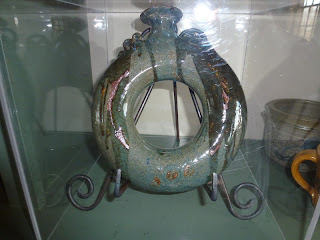Much of what we know of the life and teachings of Christ that we find in the New Testament comes from letters. Much of what we know about the early history of the church also comes from letters and journals. Mail was also very important to the people who lived in Nauvoo. Many of them were far from home and loved ones. (So are we, by the way, and would love to get some mail.)
The Post Office was usually combined with another business - as here- with the Merryweather Dry Goods Store. Sometimes it was in a home. One of the first in Nauvoo was in Sidney Rigdon's kitchen. The Post Office was pretty much where ever the sorting boxes were.
The boxes were not assigned to certain people or even families - the Postmaster just used them and his own system for sorting the mail. That thing on top is a rawhide case for carrying the mail and protecting it from the weather.
But the mail system was not very dependable. If someone had a really important letter to send, they might send it two or three times to make sure it got there. It was also quite expensive - 6 cents to go up to 30 miles. That would only get a letter from Nauvoo to Carthage. It could cost 25 - 30 cents to go more than 400 miles and that was 1/4 to 1/3 of an average daily wage.
Since they didn't know for sure if a letter would get to it's destination, they would send it COD. If a person actually got a letter, he would pay the postage. This caused a lot of problems for Joseph Smith, however. He received a LOT of mail - from friends and foes. He finally had to put an article in the newspaper saying that he would not take any mail out of the post office if the postage was not already paid. He knew his friends would understand & he wouldn't have to deal with the hate mail from his enemies.
Another way they would cut down the postage rate was by not having envelopes. That would count as another 6 cent page. They would only write on one side of the paper and then fold it up, seal it with sealing wax and address the outside.
Since they only wrote on one side of the paper, they would fill the page and then turn the page and write across what they had already written. It's really hard to read but it's a little easier if you put a plain sheet of paper under each line and move it down as you read.
You don't have to leave the Post Office to go to the store. Just walk to the other side of the room.
Merryweather Dry Goods Store
Frederick Merryweather came to Nauvoo in 1844 so many of the businesses in town were already established. He saw a need to provide everyday ordinary items that people needed to help them be self sufficient and take care of their families at reasonable prices.
He provided local pottery,
tools, nails, farm equipment, etc.
There are some interesting things in his store that you may not have seen before. Can you guess what this is? Sorry about the glare from the case.
It's a ceramic canteen. The hole allowed it to be hung over a saddle horn. They knew even back then that you have to drink more than just water in this heat to replenish nutrients so they made their own "Gatorade". They called it "Haymaker's Switzel". Here's the recipe. Yum!!!
Sounds a bit like sweet and sour sauce to me.
Another interesting item is their version of a chalk line marker. It's made of wood and has a well that they would fill with berry juice and run a string through it. Then they would snap the string to make a "berry line".
Kids love to have their picture taken with this water carrier. We let them put it on (it's VERY uncomfortable) while we tell them that the people in Nauvoo had "running water". You know - Mom would say "run down to the well and get me some water".
We really love living in the 1840's (with modern conveniences of course) and I'm even starting to like these big dresses and aprons. They really cover up a lot and I'm not sure what I will do with all my "stuff" without these handy pockets when I get home.




























































